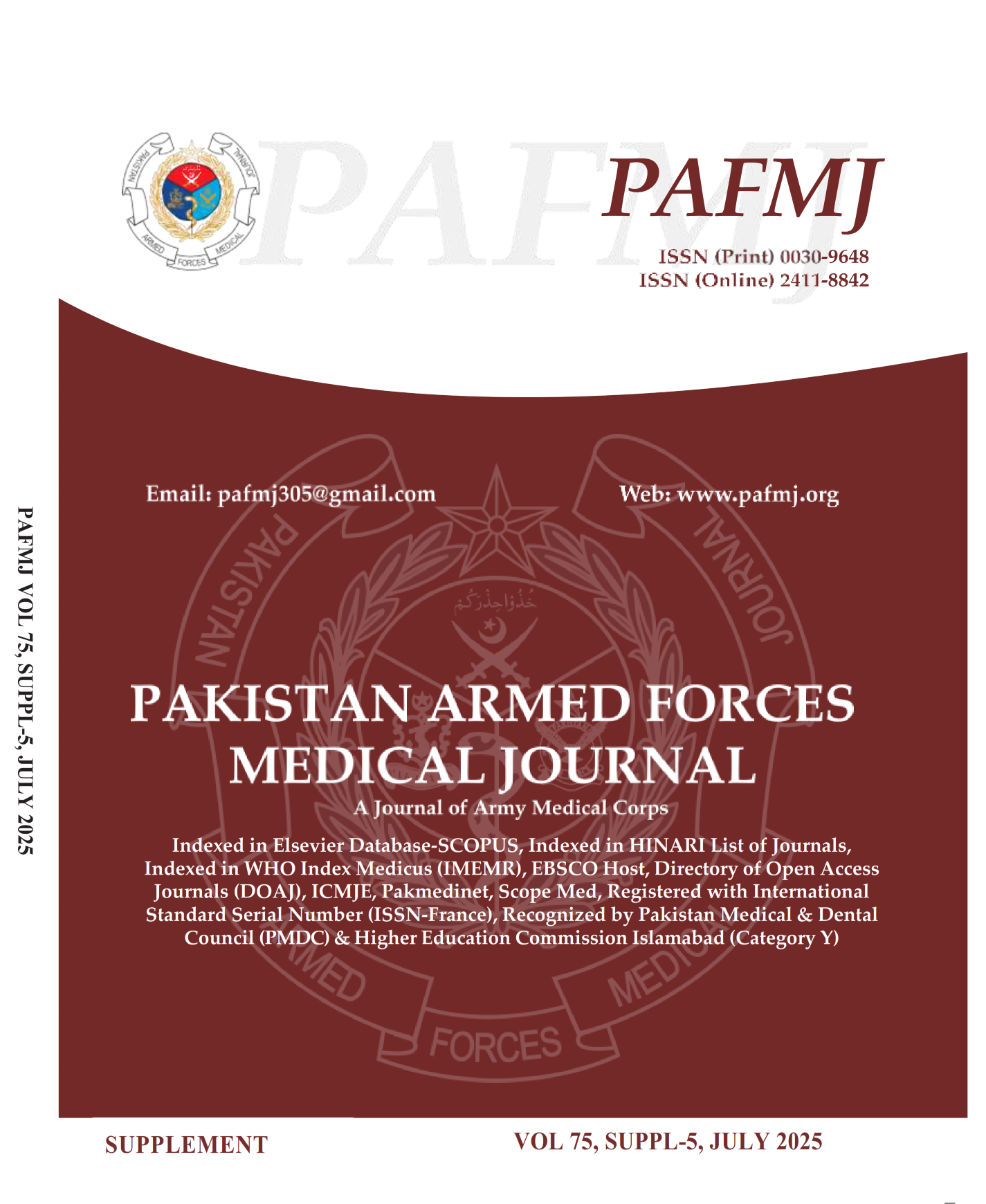The Influence of Screen Time on School Performance of Children aged 7-10 Years – A Cross-Sectional Survey
DOI:
https://doi.org/10.51253/pafmj.v75iSUPPL-5.13133Keywords:
Child Occupational Self-Assessment (COSA), visuospatial skills, school performance, Screen time.Abstract
Objective: To study the impact of screen time on school performance in children of 7-10 years of age.
Study Design: Cross-sectional Comparative survey.
Place & Duration of Study: Two schools, one Government School and one private sector school, Islamabad Pakistan from Nov 2024 to Jan 2025.
Methodology: Total 308 school going children of 7-10 years of age meeting the inclusion criteria rom two schools were included in the study. Data was collected from their parents and teachers on the parents-day meeting as per designed proforma based on Child Occupational Self-Assessment (COSA). Fine motor and visuospatial skills were also assessed and compared with daily average screen time.
Results: A total of 310 children were included having median age of 8.00(2.00) years with 178(57.4%) boys and 131(42.3%) girls. The median daily screen time reported by parents was 4.00 (2.00) hours. The class grades in academics, attitude and class participation of children were found to vary with average daily screen time (p<0.0001). The sleep hours were also associated with the attitude in the class (p=-0.644, p<0.0001). Solving time for peg board pattern was 118.50(48.00) seconds and setting the calendar was 116(53.25) seconds had significant relationship with average daily screen time (p=0.961, 0.945, p<0.0001, <0.0001) respectively.
Conclusion: Excessive screen time found to be associated with lack of interest, delayed fine motor and visuospatial learning, as well as poorer academic performance.
Downloads
References
Marciano L, Camerini AL, Morese R. The Developing Brain in the Digital Era: A Scoping Review of Structural and Functional Correlates of Screen Time in Adolescence. Front Psychol 2021; 12: 671817.
https://doi.org/10.3389/fpsyg.2021.671817
2. Orben A, Przybylski AK. The association between adolescent well-being and digital technology use. Nat Hum Behav 2019; 3(2). https://doi.org/10.1038/s41562-018-0506-1
3. Panjeti-Madan VN, Ranganathan P. Impact of Screen Time on Children’s Development: Cognitive, Language, Physical, and Social and Emotional Domains 2023; 52.
https://doi.org/10.3390/mti7050052
4. Stiglic N, Viner RM. Effects of screentime on the health and well-being of children and adolescents: a systematic review of reviews. BMJ Open 2019; 9(1): e023191.
https://doi.org/10.1136/bmjopen-2018-023191
5. Muppalla SK, Vuppalapati S, Pulliahgaru AR, Sreenivasulu H. Effects of Excessive Screen Time on Child Development: An Updated Review and Strategies for Management. Cureus 2023; 15(6).
https://doi.org/10.7759/cureus.40608
6. Suggate S, Martzog P. Children’s sensorimotor development in relation to screen-media usage: A two-year longitudinal study. Journal of Applied Developmental Psychology 2021; 74: 101279. https://doi.org/10.1016/j.appdev.2021.101279
7. Chen JY, Strodl E, Huang LH, Chen YJ, Yang GY, Chen WQ. Early Electronic Screen Exposure and Autistic-Like Behaviors among Preschoolers: The Mediating Role of Caregiver-Child Interaction, Sleep Duration and Outdoor Activities. Children (Basel) 2020; 7(11): 200.
https://doi.org/10.3390/children7110200
8. AACAP. Screen Time and Children [Internet]. [cited 2024 Sep 21]. Available from:
9. Suleman M, Sughra U, Riaz A, Akbar M. Effect of screen time on behavior of pre-schoolers in Islamabad. Pakistan Journal of Medical Sciences 2023; 39(2): 502–7.
https://doi.org/10.12669/pjms.39.2.6883
10. Kramer J, Kielhofner G, Smith E. Validity Evidence for the Child Occupational Self Assessment. The American journal of occupational therapy : official publication of the American Occupational Therapy Association 2010; 64: 621–32.
https://doi.org/10.5014/ajot.2010.08142
11. Stiglic N, Viner RM. Effects of screentime on the health and well-being of children and adolescents: a systematic review of reviews. BMJ Open 2019; 9(1): e023191.
https://doi.org/10.1136/bmjopen-2018-023191
12. Skalická V, Wold Hygen B, Stenseng F, Kårstad SB, Wichstrøm L. Screen time and the development of emotion understanding from age 4 to age 8: A community study. British J of Dev Psycho 2019; 37(3): 427–43.
https://doi.org/10.1111/bjdp.12283
13. Vidhate DS, Kadam MS, Mohite DR. Effect Of Excessive Screen Time On Bmi On Secondary School Students. Journal of Positive School Psychology 2022; 6(8): 6749–6752.
14. Chen W, Adler JL. Assessment of Screen Exposure in Young Children, 1997 to 2014. JAMA Pediatr 2019; 173(4): 391.
https://doi.org/10.1001/jamapediatrics.2018.5546
15. Rideout V. The Common Sense Census: Media Use by Kids Age Zero to Eight in America, A Common Sense Media Research Study, [United States], 2013, 2017: Version 2 [Internet]. ICPSR - Interuniversity Consortium for Political and Social Research; 2019. https://doi.org/10.3886/ICPSR37491.v2
16. Goode JA, Fomby P, Mollborn S, Limburg A. Children’s Technology Time in Two US Cohorts. Child Ind Res 2020; 13(3): 1107–32.
https://doi.org/10.1007/s12187-019-09675-x
17. Lauricella AR, Wartella E, Rideout VJ. Young children’s screen time: The complex role of parent and child factors. Journal of Applied Developmental Psychology 2015; 36: 11–17. https://doi.org/10.1016/j.appdev.2014.12.001
18. Mohd Kamaruzihan NQ, Soe MK. comparative study: Impact of screen time on sleep quality among university students and school children. JoP 2023; 3(1): 75–85.
https://doi.org/10.31436/jop.v3i1.168
19. Paulich KN, Ross JM, Lessem JM, Hewitt JK. Screen time and early adolescent mental health, academic, and social outcomes in 9- and 10- year old children: Utilizing the Adolescent Brain Cognitive Development SM (ABCD) Study. Kabir E, editor. PLoS ONE 2021; 16(9): e0256591.
https://doi.org/10.1371/journal.pone.0256591
20. Zhao C, Liu J, Li B, Ren D, Chen X, Yu J, et al. Multiscale Construction of Bifunctional Electrocatalysts for Long‐Lifespan Rechargeable Zinc–Air Batteries. Adv Funct Materials 2020; 30(36): 2003619. https://doi.org/10.1002/adfm.202003619
21. McHarg G, Ribner AD, Devine RT, Hughes C. Screen Time and Executive Function in Toddlerhood: A Longitudinal Study. Front Psychol 2020; 11: 570392.
https://doi.org/10.3389/fpsyg.2020.570392
22. Adelantado-Renau M, Moliner-Urdiales D, Cavero-Redondo I, Beltran-Valls MR, Martínez-Vizcaíno V, Álvarez-Bueno C. Association Between Screen Media Use and Academic Performance Among Children and Adolescents: A Systematic Review and Meta-analysis. JAMA Pediatr 2019; 173(11): 1058.
https://doi.org/10.1001/jamapediatrics.2019.3176
23. Karani NF, Sher J, Mophosho M. The influence of screen time on children’s language development: A scoping review. South African Journal of Communication Disorders 2022.
https://doi.org/10.4102/sajcd.v69i1.825
24. Kerai S, Almas A, Guhn M, Forer B, Oberle E. Screen time and developmental health: results from an early childhood study in Canada. BMC Public Health 2022; 22(1): 310.
Downloads
Published
License
Copyright (c) 2025 Amber Latif, Hajra Javed , Sughra Wahid , Anam Zafar , Maliha Akhtar , Sarmad Yasir Mangi

This work is licensed under a Creative Commons Attribution-NonCommercial 4.0 International License.















